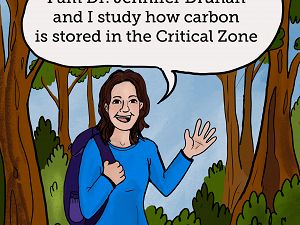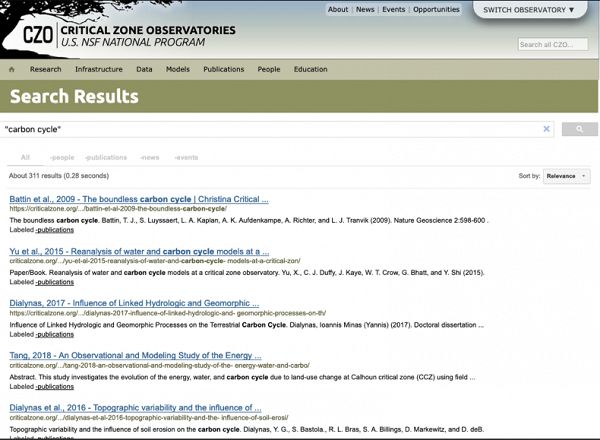Aug 12, 2019
A look at one source of carbon dioxide: Gasoline
In 2017 in the United States, we burned 391 million gallons of gasoline per day. That's more than a gallon per person per day. Each gallon weighs about six pounds, and about 5.5 pounds of that is carbon. If you put ten gallons a week into your tank, that means you're putting 60 pounds of gasoline into your car each week, and somehow, at the end of the week, that gasoline is gone. Where does it go?
This post will tell the story of a gallon of gasoline, put it into the context of the larger energy and climate systems. It is intended to amaze you, scare the heck out of you, and give you hope and courage to act to make the scary stuff less scary.
This post draws from a talk that is available on YouTube and embedded at the bottom of the post. The slides from the talk are also linked at the bottom of the post.
The purpose of this post isn't just about gasoline and carbon dioxide. It's also meant to increase understanding of why the carbon cycle and carbon sequestration are so important. Such sequestration is one of many societal benefits (services) provided by Earth's Critical Zone.
Let's consider scale
In order to understand these issues and why they matter, it's useful to have a good understanding of scale - of really big and really small numbers. Many of us can do the math, but don't really have an intuitive sense of scale.
Where do a thousand, a million, and a billion belong on this number line with end points of zero and a trillion?
If you're a teacher, try this with your students. If you're not a teacher, treat it as a mental exercise for yourself:
- Place a sticky note labeled, "zero" in one corner of the front wall of your classroom.
- In the corner on the other end of the front wall, place a sticky note labeled, "one trillion."
- Give students sticky notes and ask them to label them: One thousand, One million and One billion
- Then, have them place them where they think they belong on the wall between zero and one trillion.
What do you think they will do? What should they do? Pause and think about that.
Chances are fairly good that they will spread the stickies across the first third or half of the distance between zero and one trillion. But that's not correct; all of the stickies belong in the first one-thousandth of the distance! Though many of us recognize this when we stop and think, people tend to think of millions, billions and trillions as simply really big numbers. Scale matters.
Most of us probably have a sense of a thousand. The computer I'm using now costs about a thousand dollars. You may have gone to a high school with about a thousand students.
The bigger numbers are harder to grasp
Each of these named numbers is a thousand times larger than the last. A million is a thousand thousand. A billion is a thousand million. And a trillion is a thousand billion. Thinking about seconds is helpful:
A thousand seconds is about 17 minutes.
A million seconds is about 12 days.
A billion seconds is about 32 years.
A trillion seconds is about 32,000 years.
Homo sapiens (us!) have been around for about 10 trillion seconds.
Keep all of this in mind as we consider that the gallon of gasoline we're discussing here is one of 390 million burned on the average day in the US.
Back to that gallon of gasoline...
Again, a gallon of gasoline weighs about six pounds, so if you burn 10 gallons a week, you're burning 60 pounds/week. What becomes of that?
We know that matter can neither be created nor destroyed, only changed in form. To understand that transformation, we need to know more about what gasoline really is.
Gasoline is a complex chemical mixture made of many different compounds. It is made by refining petroleum, which is also known as crude oil, or simply, "oil." Petrolieum is a fossil fuel. It formed when algae and other single-celled organisms settled to the bottom of ancient seas, was buried, compacted, and was subjected to heat and pressure over millions of years. Natural gas formed in much the same way. The process for coal formation is similar, but coal formed from the burial and decay of plants in swampy areas on land, not in the sea. Coal formation took place in the Critcal Zone.
The exact chemistry of gasoline varies from gallon to gallon, depending on where the oil that it's made from originated, additives, and more. But, on average, its chemical composition is C8H18. If you know some chemistry, you might recognize that as a hydrocarbon, and might know its name or be able to figure it out knowing that its a hydrocarbon with 8 carbon atoms - and you may have seen the name of it on gasoline pumps: octane.
What do you get when you burn octane? Carbon dioxide (CO2), and water (H2O). And energy, of course.
Combustion of octane
The below 30-second animation of the combustion of octane (C8H18) shows molecules of oxygen and octane breaking apart and recombining into water and carbon dioxide:
Whoa, the resulting gas is heavier than the gasoline?
The resulting carbon dioxide (CO2) and water (H2O) weighs more than the gasoline we started with! That's because the reaction used oxygen from the air, not just the gasoline. Burning a six pound gallon of gasoline yields 19 pounds of CO2! Yikes, that's a weight increase of more than 300%!
How many balloons does it take to hold 19 pounds of carbon dioxide?
A gallon of gasoline is pretty easy to picture. And it doesn’t seem weird to think that it weighs six pounds. But nineteen pounds of an invisible gas, like carbon dioxide, is a bit harder to understand.
An inflated balloon weighs more than an empty one, because the air (or other gas) inside does weigh something.
What do you think?
How many gallon-sized balloons would it take to hold 19 pounds of carbon-dioxide?
If you can, get a balloon. If not, use your imagination. Hold it empty and think about how much it weighs. Fill it up to about the size of a gallon jug. Think about how much it weighs now.
It doesn’t weigh very much, does it? What are some things that weigh about 19 pounds? Remember as you ponder this that you are just considering the weight of the gas inside the balloons and must substract the weight of the balloons themselves.
Here comes the answer...
... about 1100 gallon-sized balloons!
The carbon dioxide emissions from burning a single, 6-pound gallon of gasoline weigh about 19 pounds and have a volume of about 1100 gallons (about 150 cubic feet) in the the atmosphere.
Our carbon emissions add up really fast
Remember that Americans burn 391 million gallons of gasoline a day.
That’s over 7 billion pounds of CO2 produced every day just from burning gasoline. That's just in the United States.
Um, wow.
A gallon of gasoline is about 87% carbon by weight. That means there’s about 5.5 pounds of carbon in a gallon of gas.
Visualizing carbon in graphite form
The below animation shows how much carbon is in a gallon of gasoline using graphite as an example. Graphite is pure carbon. A gallon of gasoline contains 5.5 pounds of carbon - the equivalent of a block of graphite that's 6" x 6" x 2". A U.S. quarter coin is included for scale.
How much wood do you have to grow to take the carbon from burning a gallon of gasoline back out of the air?
Wood is 45% - 50% carbon. So, 11 pounds of wood needs to be grown to sequester each gallon of gasoline we burn.
Um, wow... again.
And it can’t be allowed to burn or decay. A standard 8 foot 2x4 weighs 11 pounds. (An 8 foot 2x4 is perhaps the most common piece of lumber).
And how much wood needs to be grown in the U.S. per year to sequester our gasoline?
We need to grow a 2x4’s worth of wood for each of the 390 million gallons of gasoline we burn everyday.
390 million 2x4s a day.
11 pounds x 390 million = 4,290,000,000 pounds of wood, every day.
That’s more than 1.5 trillion pounds a year.
Wow.
Remember what a trillion really means. (Scroll back up to the begining of this post if you need to).
Don't forget about coal and natural gas too
That "1.5 trillion pounds of wood a year" number is just to sequester our gasoline; we also burn about 2 million tons (4 billion pounds) of coal a day. The chemistry and mathematics are similar.
In addition, we burn about 75,000 million cubic feet (mcf) of natural gas on the average day. While natural gas produces less CO2 per unit of energy when compared to other fossil fuels, that still yields about 4,000 tons (8 million pounds of CO2) for the typical day. And natural gas’s primary component, methane (CH4), is a powerful greenhouse gas that leaks to the atmosphere along the pipeline.
Carbon dioxide emissions from transportation are mostly from burning gasoline, diesel, and jet fuel. Emissions from burning diesel oil and jet fuel are slightly higher per gallon than gasoline - over 21 pounds per gallon.
The burning of these liquid transportation fuels account for about a quarter of total US carbon dioxide emissions. That means when we think about addressing all of our emissions, we need to multiply the emissions - and the consequences of these emissions - by four.
Our carbon emissions really are a BIG BIG problem
The above arguments clearly show how 5.5 pounds of carbon per gallon of gasoline really adds up to enormous emissions that would need a tremendous number of new growing trees to sequester (isolate) that carbon from the atmosphere.
Comparing the volume of a gallon of gasoline to the volume of carbon within it, if the carbon was solid (in the form of graphite).
Given these very large numbers, is it realistic to assume that changing atmospheric chemistry to this extent can be done without consequences?
NO.
So, um, where does the courage and hope come in then?
Our understandings of both the physical and social world are improving and this gives us hope and informs our courage.
We are gaining a better understanding of how carbon moves and how it is stored
Earth's Critical Zone. Illustration by Critical Zone Observatories (CZO), based on a figure in Chorover et al. 2007.
Better understanding of climate change, the carbon cycle, and carbon storage are essential areas of study in Critical Zone science. The answer to the question, "Where does gasoline go?" is, of course, "The Critical Zone."
A brighter future depends on improving our knowledge of how combustion plays out millions upon millions of times each day; how that reaction alters atmospheric chemistry; and how those alterations drive climate change.
Appreciating the scale of our impact should help us to shrink it; to drive us to drive less, or at least to move in ways that are less carbon intensive.
Critical Zone Science helps us understand how carbon circulates and is stored in the Earth system. Carbon storage is an essential Critical Zone Service (see an example cartoon, science article, or 50-minute video). A stunning fact of human activity in the Critical Zone is that each gallon of gasoline we burn produces 19 pounds of carbon dioxide by combining the 5.5 pounds of carbon in that gallon of gasoline with oxygen from the atmosphere. One likely piece of the solution is to put less carbon into the air by burning less stuff.
We can also reduce harms by pulling the carbon we've added to the atmosphere back out. Doing so is a crucial Critical Zone service. Understanding how carbon moves and where it is stored in rock, water, soil, air and life is essential to mitigating climate change.
We have a history of responding to horrifying credible predictions
We've been talking about the end of the world, or the end of society, anyway, for as long as we've been human. We've always been wrong. There's hope in that, but it's essential to look at why those previous predictions have been wrong.
There are at least two reasons that those apocalyptic prophecies haven't come to pass:
1. Some of them were just wrong.
2. Credible predictions led to action.
Unfortunately, climate scientists' predictions have held true in a stunning number of cases. Climate change is real, human caused, and a serious problem we are facing now. It is not just a distant problem, though the situation will worsen. Extreme floods, fires, hurricanes, droughts, and heat waves have all been forecasted to worsen as a result of all of the carbon we have added to the atmosphere. The predictions have come true. The predictions about what lies ahead are highly credible.
The hope and the courage comes by recognizing that credible predictions lead to action
71% of Americans believe that climate change is happening. Many of us are acting now. Many of us are not. Almost no matter where you are in terms of your actions, it is time to ramp them up. One of the most important things we can do is talk about climate change. Talk to your friends and families. Talk to the people you do business with or refuse to do business with because of how their practices impact the environment. And, maybe most importantly, talk to your legislators.
Let's get to it.
Going Further
The above post is intended to help build understanding of why carbon sequestration and the carbon cycle more broadly are important, but it doesn't go deeply into understanding those processes.
Here are a few resources to help you learn and teach about the carbon cycle:
- An interactive diagram, with embedded videos explaining different parts of the carbon cycle:
- The Carbon Cycle Toolkit: (a more in depth look):
A diagram of the biological components of the carbon cycle. Source: https://public.ornl.gov/site/gallery/originals/BioComponents_Carbon.jpg
Earth's Critical Zone plays key roles in the carbon cycle, so it is no surprise that it is an important area of study for Critical Zone scientists.
• See search results for "carbon cycle" on CriticalZone.org.
• See search results for "carbon sequestration" on CriticalZone.org
For learning and teaching about Climate change more broadly, consider The Teacher-Friendly Guide™ to Climate Change.
When exploring actions that you can take to combat global climate change, please visit Act on Climate.
For more about predicting the end of the world, and thoughts on why we need to be thoughtful when talking about such things in relation to climate change, see a Prezi presentation: "Fire and Brimstone and Fort McMurray: Considering the Implications of Apocalyptic Rhetoric in Climate Communication." The video below includes this presentation in addition to the content of this blog post.
Watch a 53-minute video about this content
Where do a thousand, a million, and a billion belong on this number line with end points of zero and a trillion?
The author pictured with an 8' 2x4.
Comparing the volume of a gallon of gasoline to the volume of carbon within it, if the carbon was solid (in the form of graphite).
A diagram of the biological components of the carbon cycle. Source: https://public.ornl.gov/site/gallery/originals/BioComponents_Carbon.jpg
Searching for "carbon cycle" on CriticalZone.org yields hundreds of hits.
1100 balloons filled with CO2 gas from burning a single gallon of gasoline.
Earth's Critical Zone. Illustration by Critical Zone Observatories (CZO), based on a figure in Chorover et al. 2007.
Files
Where Does Gasoline Go?
(14 MB key)
This is an Apple Keynote Presentation of the content of this blog post.
Where Does Gasoline Go?
(39 MB pptx)
This is a PowerPoint Presentation of the content of this blog post. The presentation was originally created in Apple Keynote, and the animations work better in that format.

Don Haas
CZO INVESTIGATOR, STAFF. Outreach-Education. Specialty: Place-based Earth Science Education, Teacher Professional Development, & Curriculum Development
Climatology / Meteorology Outreach / Education Research EDUCATION/OUTREACH General Public K-12 Education Higher Education
COMMENT ON "Adventures in the Critical Zone"
All comments are moderated. If you want to comment without logging in, select either the "Start/Join the discussion" box or a "Reply" link, then "Name", and finally, "I'd rather post as a guest" checkbox.
ABOUT THIS BLOG
Justin Richardson and his guests answer questions about the Critical Zone, synthesize CZ research, and meet folks working at the CZ observatories
YOU MAY LIKE

How do people manage carbon in soil?
Climate change. These two words illicit many feelings. Those in low lying areas dotted around the world’s oceans fear future sea level rising....
Justin Richardson

Exploring carbon dioxide sources at Eel River CZO
An illustrated introduction to Dr. Jennifer Druhan's research on how carbon is stored in the Critical Zone. By Drs. Jennifer Druhan...
Jennifer Druhan
General Disclaimer: Any opinions, findings, conclusions or recommendations presented in the above blog post are only those of the blog author and do not necessarily reflect the views of the U.S. CZO National Program or the National Science Foundation. For official information about NSF, visit www.nsf.gov.
Explore Further









